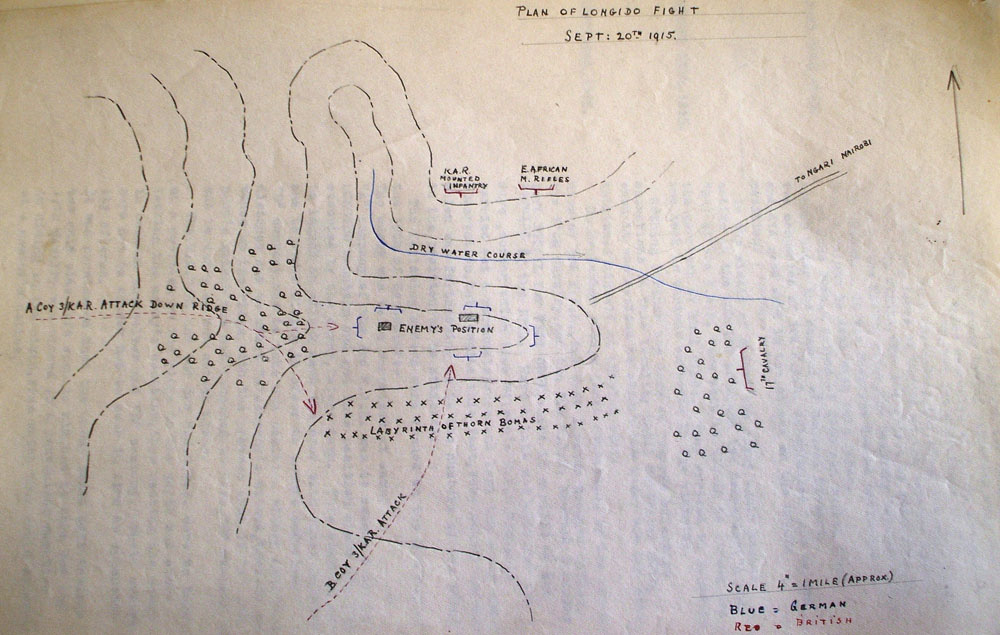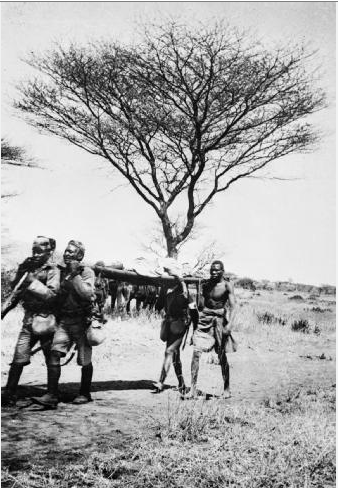Battle of Longido West
Sally Wilson
Longido Mountain is located to the north-west of Kilimanjaro just inside German East Africa (present-day Tanzania). Several skirmishes had been fought at this location with the British taking control of the area in November 1914. In August 1915, the Germans had returned to the area and taken over the abandoned camp and started to show signs of activity.
Because British troops in the area were sparse, Companies A and B of the 3rd Battalion of the King’s African Rifles were sent to Bissil, some miles north of Longido in British East Africa, to strengthen the troops there. Thomas Wilson had recently joined B Company of 3/KAR in Nairobi and was with them when they arrived in Bissil on August 26th. The two companies of 3/KAR remained in Bissil with the East African Mounted Rifles (E.A.M.R), the 17th Cavalry and Mounted Rifles of 3/KAR until September 16 when they moved out to West Orok under the command of Lieutenant-Colonel Jollie in preparation for an attack on Longido on September 20.
During the two days the troops were readying in West Orok, E.A.M.R. scouts were sent on a reconnaissance mission to observe the enemy. The German camp was well-hidden among the rocks and was well-defended, so little useful information was gleaned as to the strength of the enemy’s position.
The plan was to launch a surprise attack at dawn on the morning of September 20. A Company of 3/KAR was to get in position above the enemy on Longido Mountain before first light when they would proceed with a silent bayonet attack. B Company was to take up position below the enemy and were to advance up the ridge when Company A started the attack. Even if A Company was not able to reach their position by dawn, B Company was instructed to attack. The E.A.M.R. and K.A.R. Mounted Infantry (K.A.R.M.I.) were to position themselves on a ridge to the north overlooking the enemy’s position. The idea was that the enemy, surrounded on three sides, would have to retreat in the only direction left open to them and into the arms of the 17th Cavalry who were to be awaiting on the plain.

All did not go according to plan. A Company of KAR was not able to reach their position by dawn. B Company proceeded alone, but quickly became entangled in thorn bomas that had been erected as defence by British troops that had previously occupied the area. This resulted in splitting B Company into several smaller groups. The noise made by these men attempting to communicate with one another alerted the Germans of the attack. As B Company crested the ridge they were met by heavy fire from the Germans and, unfortunately, from the E.A.M.R. and K.A.R.M.I. on the opposite ridge. Meanwhile, A Company eventually reached their position and descended upon the enemy; however, while descending, they split into two groups. One group succeeded in reaching its objective, but the other descended into B Company.
The situation got worse as casualties started to mount and communication was difficult. Meanwhile, the 17th Cavalry who were to cut off the retreating Germans inadvertently advertised their position by sending up large clouds of dust as they moved about on the plain. This alerted the Germans to the dangers of retreat in that direction.
Little progress was made and the mounted troops retired at 11 am. An hour later 3/KAR was sent the order to retire, but by then they had suffered 41 casualties. Although the attack did not achieve it’s initial objective, the Germans did evacuate Longido that night.

The official record of the actions of 3/KAR makes note of Thomas Wilson’s contribution to this battle:
Lieut. T. Wilson, who was in command of the machine gun detachment, did excellent work in this action and was awarded the Military Cross for his gallant conduct in mending his machine gun, which had been put out of action, under heavy fire.5.
The East African Mounted Rifles (E.A.M.R.) was a unit made up of British settlers who had been living in British East Africa when the war broke out.
A boma can be a livestock enclosure, a stockade or a kind of fort. They were built of poles, stones or impenetrable thickets of acacia thorns.
